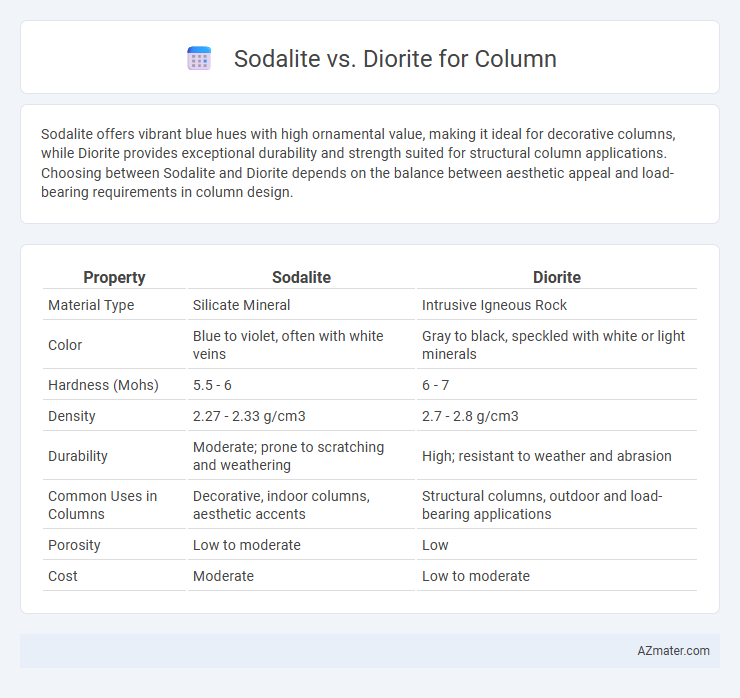Sodalite offers vibrant blue hues with high ornamental value, making it ideal for decorative columns, while Diorite provides exceptional durability and strength suited for structural column applications. Choosing between Sodalite and Diorite depends on the balance between aesthetic appeal and load-bearing requirements in column design.
Table of Comparison
| Property | Sodalite | Diorite |
|---|---|---|
| Material Type | Silicate Mineral | Intrusive Igneous Rock |
| Color | Blue to violet, often with white veins | Gray to black, speckled with white or light minerals |
| Hardness (Mohs) | 5.5 - 6 | 6 - 7 |
| Density | 2.27 - 2.33 g/cm3 | 2.7 - 2.8 g/cm3 |
| Durability | Moderate; prone to scratching and weathering | High; resistant to weather and abrasion |
| Common Uses in Columns | Decorative, indoor columns, aesthetic accents | Structural columns, outdoor and load-bearing applications |
| Porosity | Low to moderate | Low |
| Cost | Moderate | Low to moderate |
Introduction to Sodalite and Diorite Columns
Sodalite columns showcase a striking deep blue color with white veining, making them a popular choice for decorative architectural elements due to their unique mineral composition and visual appeal. Diorite columns, composed primarily of plagioclase feldspar and quartz, offer a durable and coarse-grained texture with a speckled black-and-white appearance ideal for structural and ornamental uses. Both sodalite and diorite columns provide distinct aesthetic and physical properties suited for various design and construction applications.
Geological Origins of Sodalite and Diorite
Sodalite forms in intrusive igneous rocks, primarily in nepheline syenites and other alkaline igneous environments, characterized by its rich sodium content and distinctive blue color. Diorite originates from intermediate intrusive igneous activity, crystallizing slowly from magma composed mainly of plagioclase feldspar, hornblende, and biotite, resulting in a coarse-grained texture. The contrasting geological origins influence their mineral compositions and aesthetic qualities, making sodalite valued for decorative columns and diorite prized for structural strength.
Physical Properties Compared: Sodalite vs Diorite
Sodalite and Diorite differ significantly in physical properties relevant to column construction, with Sodalite exhibiting a lower hardness of around 5.5-6 on the Mohs scale compared to Diorite's hardness of 6-7, making Diorite more resistant to abrasion and wear. Diorite's coarse-grained texture provides superior strength and durability, offering higher compressive strength ideal for structural applications, whereas Sodalite's moderate density and vibrant blue coloration primarily suit decorative uses. The porosity and water absorption of Diorite are generally lower than Sodalite's, contributing to better resistance against weathering and moisture-related damage in outdoor column installations.
Visual Appeal and Color Variations
Sodalite displays a rich royal blue hue with striking white veining, offering a dramatic and elegant visual appeal ideal for bold column designs. Diorite, characterized by its speckled mix of black, white, and gray tones, provides a more subdued and sophisticated look with subtle color variations that complement modern architectural styles. Both stones deliver unique aesthetic qualities, with Sodalite standing out for vibrant color contrast, while Diorite excels in neutral, textural complexity.
Durability and Strength for Structural Columns
Sodalite exhibits moderate durability and strength, making it more suitable for decorative rather than load-bearing structural columns. Diorite, a coarse-grained intrusive igneous rock, offers superior compressive strength and excellent durability, ideal for structural columns requiring high load-bearing capacity. Its dense interlocking mineral grains provide resistance against weathering and mechanical stress, ensuring long-term stability in construction applications.
Weather Resistance and Maintenance Needs
Sodalite exhibits moderate weather resistance but requires regular sealing to prevent discoloration and surface degradation, making maintenance more intensive compared to diorite. Diorite is highly durable with excellent resistance to weathering, requiring minimal maintenance due to its dense, hard mineral composition. For columns exposed to harsh environmental conditions, diorite offers superior longevity and lower upkeep costs over sodalite.
Cost Comparison: Sodalite vs Diorite
Sodalite columns generally command a higher price due to their rarity and vibrant blue hues, making them a premium choice for luxury projects. Diorite, being more abundant and having a muted, speckled appearance, offers a more cost-effective option for structural and decorative columns. The price difference can influence project budgets significantly, with Sodalite often costing two to three times more than Diorite per square foot.
Applications in Architecture and Interior Design
Sodalite and Diorite serve distinct roles in architecture and interior design due to their unique aesthetic and physical properties. Sodalite, prized for its vibrant blue hues and striking veining, is frequently used as decorative cladding, countertops, and feature walls to create bold interior focal points. Diorite's durability and granular texture make it ideal for structural columns and exterior columns, offering both functional strength and a sophisticated, speckled appearance in modern and traditional architectural projects.
Sustainability and Environmental Impact
Sodalite and Diorite both offer durable options for columns, but Sodalite is less common in construction, often sourced from limited quarries, which can increase environmental impact due to transportation and extraction practices. Diorite, widely available and sometimes locally sourced, generally has a lower carbon footprint and reduced habitat disruption during quarrying. Choosing Diorite can enhance sustainability efforts by minimizing resource depletion and promoting eco-friendly building materials.
Choosing the Right Stone for Your Column Project
Sodalite offers vibrant blue hues with white veining, ideal for decorative columns where aesthetic appeal is prioritized, while diorite provides enhanced durability and a speckled, granite-like appearance suited for structural columns requiring strength and resilience. Choosing the right stone depends on project-specific needs such as load-bearing requirements, weather resistance, and visual impact; diorite excels in outdoor and high-stress environments, whereas sodalite is better for interior or accent columns. Cost considerations and availability also influence the decision, with diorite generally being more accessible and cost-effective for large-scale construction.

Infographic: Sodalite vs Diorite for Column
 azmater.com
azmater.com